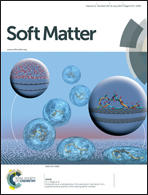Effect of surface modification on interfacial nanobubble morphology and contact line tension†
Abstract
Past research has confirmed the existence of surface nanobubbles on various hydrophobic substrates (static contact angle >90°) when imaged in air–equilibrated water. Additionally, the use of solvent exchange techniques (based on the difference in saturation levels of air in various solvents) also introduced surface nanobubbles on hydrophilic substrates (static contact angle <90°). In this work, tapping mode atomic force microscopy was used to image interfacial nanobubbles formed on bulk polycarbonate (static contact angle of 81.1°), bromo-terminated silica (BTS; static contact angle of 85.5°), and fluoro-terminated silica (FTS; static contact angle of 105.3°) surfaces when immersed in air–equilibrated water without solvent exchange. Nanobubbles formed on the above three substrates were characterized on the basis of Laplace pressure, bubble density, and contact line tension. Results reported here show that (1) the Laplace pressures of all nanobubbles formed on both BTS and polycarbonate were an order of magnitude higher than those of FTS, (2) the nanobubble number density per unit area decreased with an increase in substrate contact angle, and (3) the contact line tension of the nanobubbles was calculated to be positive for both BTS and polycarbonate (lateral radius, Rs < 50 nm for all nanobubbles), and negative for FTS (Rs > 50 nm for all nanobubbles). The nanobubble morphology and distribution before and after using the solvent exchange method (ethanol–water), on the bulk polycarbonate substrate was also characterized. Analysis for these polycarbonate surface nanobubbles showed that both the Laplace pressure and nanobubble density reduced by ≈98% after ethanol–water exchange, accompanied by a flip in the magnitude of contact line tension from positive (0.19 nN) to negative (−0.11 nN).


 Please wait while we load your content...
Please wait while we load your content...